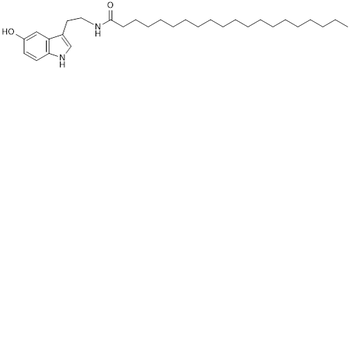You have no items in your shopping cart.
Cart summary
Item 1 of 1
Eicosanoyl-5-hydroxytyptamide
Catalog Number: orb2652562
| Catalog Number | orb2652562 |
|---|---|
| Category | Small Molecules |
| Description | A neuroprotective natural product found in coffee |
| Form/Appearance | Beige powder |
| Purity | >98% (TLC); NMR (Conforms) |
| MW | 470.7 |
| Source | Synthetic |
| Solubility (25°C) | May be dissolved in DMSO (30 mg/ml); or ethanol (20 mg/ml, warm) |
| Formula | C30H50N2O2 |
| Storage | -20°C |
| Alternative names | Eicosanoyl serotonin; Eicosanoyl-5-hydroxytryptami Read more... |
| Hazard Information | Classification: Caution- Substance not yet fully tested. Safety Phrases: S22 - Do not breathe dust S36/37/39 - Wear suitable protective clothing, gloves and eye/face protection S24/25- Avoid contact with skin and eyes |
| Note | For research use only |
| Expiration Date | 12 months from date of receipt. |

Chemical structure of Eicosanoyl-5-hydroxytyptamide, a A neuroprotective natural product found in coffee. CAS #: N/A. Molecular Formula: C30H50N2O2. Molecular Weight: 470.7 g/mol.
For example, if the dosage of your experiment is 10mg/kg, the weight of each animal is 50g, and the volume of the dosing is 100μL, then the working solution concentration of your experiment is 5mg/mL. If the formula you used is 5% DMSO+ 30% PEG300+ 5% Tween 80 + 60% Saline/PBS/ddH2O, the preparation method is as follows:
Mother liquor preparation method: 5mg of drug dissolved in 100μL DMSO (mother liquor concentration is 50mg/mL). Preparation method of in vivo formulation: For 1mL of working solution preparation, take 50μL of DMSO mother liquor, add 300 μL of PEG300 to mix well and clarify, then add 50μL of Tween-80 to mix well and clarify, and finally add 600μL of Saline/PBS/ddH2O to mix well and clarify.Note:
- For Reference Only. Please choose the appropriate dissolution protocol according to your experimental animal and administration method.
- We suggest that in cell experiments, the final concentration of DMSO is not more than 0.1%, in animal experiments, for healthy mice, the final concentration of DMSO is not more than 10%; For nude or frail mice, the final concentration of DMSO is not more than 2%.


